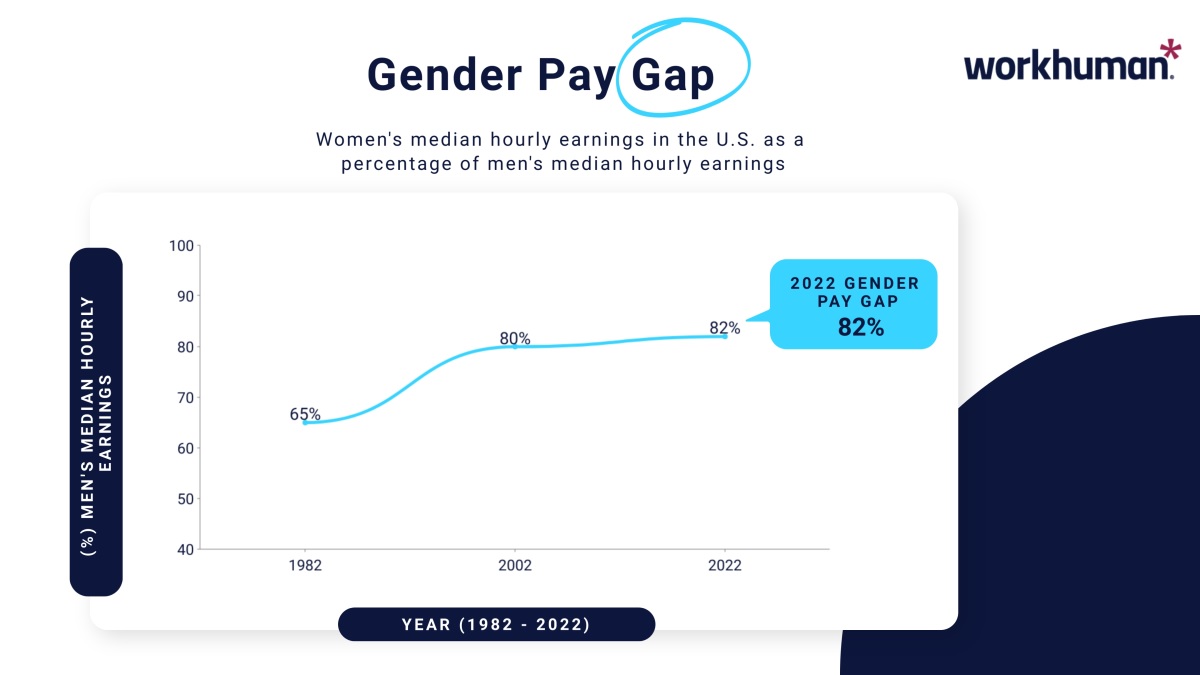Achieving Pay Equity: Laws, Benefits, and Strategies for Organizations

In order to maintain pay equity within their organizations, leaders must be aware of local and state legislatures, encourage salary transparency, and analyze their implicit biases. They must also complete pay equity analyses periodically to ensure that employees in similar roles are being paid comparable salaries, regardless of their personal identities.
Read on to gain a deeper understanding of why this issue is so fundamental, as well as best practices to ensure all employees are being paid fairly within your workforce.
What is pay equity?
Pay equity is simply the promise of equal pay for equal work. There are legal protections in place for employees based on biological sex, but related policies often extend to gender presentation, race, ethnicity, religion, or other classes protected by federal, state, and local governments. Beyond financial equity, fair pay practices also help foster diversity and inclusion in the workplace.
Why is pay equity so important?
Pay equity is important because it helps create an equitable workplace where all employees are treated fairly, beginning at the essential level of compensation. Ensuring that employees with equal job duties receive equal wages creates an egalitarian environment where efficiency, creativity, and productivity can flourish.
Knowing that they're being compensated fairly and equally can help employees feel motivated and engaged. Unfortunately, according to a survey of 2,000 active employees by Beqom in their 2022 Compensation and Culture Report, 43% of US employees who disclosed their salaries to a coworker discovered that they were earning less than that colleague.
These pay disparities can cause frustration, interpersonal resentment, distrust of management, and lower job satisfaction.
On the other hand, ensuring fair, equitable employee compensation can:
- Enhance employee morale
- Improve motivation and work performance
- Increase retention
- Promote diversity, equity, and inclusion
- Support a financially equitable society
- Boost brand perception
- Help attract top talent
- Protect organizations from lawsuits
It's imperative that organizations begin to take a deeper look at their internal biases and how these are affecting employee compensation packages. Beyond the universally acknowledged gender pay gap, is there a measurable financial bias toward employees of various races, ages, body sizes, abilities, or other factors?
How about introverts vs. extroverts? Working parents? Employees who prefer remote work over in-office? Transgender employees?

While it can be a sobering practice, it's extremely important to use a wide lens when considering all the factors that could be impacting differences in pay between employees. During this process, leaders should also familiarize themselves with the laws put in place to protect these employees in order to ensure compliance.
What are pay equity laws?
Pay equity laws are specific protections created to help ensure that all employees receive equal pay for equal work, helping to close wage gaps between workers. Some notable pay equity laws include:
The Fair Labor Standards Act of 1938
The Fair Labor Standards Act of 1938 was created to help abolish child labor within the U.S. It also mandated a 40 cents per hour minimum wage, a 40-hour maximum workweek, and made the legal working age 16 in most industries.
Ensuring employees were compensated fairly and that children weren't being forced to work was a huge step for employee protections to come.
The Equal Pay Act of 1963
The Equal Pay Act of 1963 holds special importance, as it was the first piece of legislation put in place to protect pay equity and close the gender pay gap. The federal Equal Pay ActOpens in a new tab requires employers to pay men and women equally for “substantially equal” work.
“Pay” also extends to compensation beyond salary, such as bonuses, stock options, travel reimbursements, and benefits. This act laid a strong foundation for additional legal protections to come.
Title VII of the Civil Rights Act of 1964
This act expanded on the Equal Pay Act by prohibiting pay discrimination due to an employee’s “race, color, religion, sex, or national origin.” It also was intended to have a wider scope than the original act by prohibiting wage discrimination when roles were comparable, but not identical. These laws apply to workplaces with 15 or more employees.

EEO-1 Wage Reporting
The EEO-1 Wage Reporting is a required annual survey of all employers in the private sector with 100 or more employees, as well as federal contractors with 50+ employees. This report was mandated by Title VII of the Civil Rights Act of 1964 and is administered yearly by the Equal Employment Opportunity Commission (EEOC) to ensure compliance.
Employers are required to report compensation data, including information on employees' salaries and job categories, as well as their sexes and races/ethnicities. Analyzing this data helps ensure that employees are being compensated fairly and that no discrimination-based wage discrepancies are apparent.
The Age Discrimination in Employment Act of 1967
The Age Discrimination in Employment Act of 1967 protects potential and current employees who are 40+ years oldOpens in a new tab. This act prevents discrimination based on age in compensation, hiring, promotion, and other conditions of employment. This law helps protect workers from ageism in the workplace and ensures that older employees aren’t being pushed out of their roles.
The Americans with Disabilities Act of 1990
The Americans with Disabilities Act of 1990 was created to protect Americans with physical, intellectual, and psychological disabilities in the world of work. Beyond requiring fair pay, this act also mandates appropriate workplace accommodations and other equitable employment practices. This helps ensure that these individuals have equal opportunities for career advancement and can work toward financial independence.
The Lilly Ledbetter Fair Pay Act of 2009
Signed into law by President Obama, the Lilly Ledbetter Fair Pay Act of 2009 requires employers to keep meticulous records regarding pay data and employee salary history.
This helps ensure that pay decisions are being made fairly and that any cases of salary discrimination are being addressed in a timely manner. It also provides victims of pay discrimination in the workplace with evidence to support their cases.
The Equality Act (proposed)
This proposed amendment to the Civil Rights Act of 1964 was designed to protect LGBTQ+ employees from discrimination in employment, housing, and other vital areas of life.
Because federal law does not explicitly protect individuals on the basis of sexual orientation or gender identity/expression, this proposed act would be an extremely valuable addition to the legal protections in place for U.S. employees.
How can I foster better pay equity in my organization?
Overcoming pay equity challenges within your organization begins with taking a holistic inventory of your current systems and making small steps forward. This may look like:
Ensuring compliance with state and local pay equity laws and regulations
It's up to your payroll and finance teams to update and modernize your workplace policies to ensure your organization is enforcing federal laws in terms of pay equity. Ensuring basic compliance is a fundamental step toward building a truly equitable workplace.
Identifying pay discrepancies
Improving pay equity within your company begins with an accurate analysis of your current employees' salaries, roles, responsibilities, and identities. This may include comparing salaries by gender and race to see if any patterns of bias are present. If these issues come up, it's important to create a pay policy to help your organization pay employees more fairly in the future.

Promoting based on performance and tenure
It's important to recognize employees for their hard work during promotion cycles. Too often, extroverted employees or those who have stronger relationships with managers are chosen for promotions, while others with equal or greater job performance are overlooked. It's very important for leaders to reevaluate how career advancement works within their organizations and why.
Listing salary ranges in job descriptions
Being transparent with prospective employees on the base pay for a role helps address pay equity from the very beginning. Not only does this give them the opportunity to advocate for fair wages from the interview stage, but it also ensures that all applicants are targeting the same pay scales. That way, no one is moving forward with an unfair advantage, or being surprised with an offer far outside the assumed salary band.
Implementing diverse hiring practices
Analyzing implicit biases in hiring can be complicated, as it often requires leaders to confront their own unconscious biases. Corporate DEI training and workshops on equitable hiring practices can be very impactful when trying to make progress on company DEI initiatives like building a more diverse staff and eventually, a more inclusive culture.
You might also like: Promoting DEI in the workplace
Prohibiting employers from asking job applicants personal questions
It's important to remind hiring managers that asking prospective employees about their marital or parental status can be highly problematic. Job applicants have a right to privacy, especially when questions such as these have historically been used to discriminate against women in the workforce.
What is a pay equity audit and how do I conduct one?
A pay equity audit, also called a pay equity analysis, is a process to identify pay inequities within a workplace. This process can become increasingly complex depending on the size of the organization and the number of identity factors being considered.
Follow the steps below to perform a pay equity analysis within your company:
1) Determine what needs to be measured
While pay disparities between men and women or employees of different races may be the most obvious to measure, it's important to step back and analyze other factors that may be contributing to pay inequity within your company. Are there noticeable differences in the way you pay and reward your employees? It's up to your team to investigate the root causes for these issues so they can be alleviated.
2) Analyze data internally or externally
A pay equity audit identifies disparities in employee pay that cannot be explained by legitimate factors like tenure, educational background, prior work experience, etc. Conducting a regression analysis of this data, either in-house or in partnership with an organization that specializes in statistical analysis can help you find a starting point to create change.
3) Examine your findings
The first step is to identify if the pay differences you've discovered can be explained by legitimate reasons or are true indicators of bias. Any unexplained pay issues that are found during your audit should be taken extremely seriously. You can use these disparities as fuel to create better policies and protections for your current and future employees.

4) Implement improved policies
Once you've identified all the current pay equity issues, it's time to develop remediation strategies to address them. These policies and practices may include pay adjustments for existing employees who aren't being justly compensated for their labor, encouraging salary transparency, and changing pay structures to make them more equitable in the future.
5) Monitor your progress year over year
Performing a pay equity audit annually is a great way to ensure that things are staying on track and that all your employees are paid equitably. Yearly pay audits can also help you gauge the success of your pay equity policies and see where tweaks or improvements are needed.
FAQs
What is the current pay gap between women and men?
Despite the dedicated efforts of many leaders, wage discrimination based on gender unfortunately still exists. In 2022, American women earned 82 cents per dollarOpens in a new tab that their male cohorts earned. In order to fully close this gap and pay men and women equally, employers must prioritize pay equity and fair compensation practices in the coming years.
What is Equal Pay Day?
Equal Pay Day is an annual event to raise awareness about salary discrepancies between employees. Participants are asked to wear red to symbolize how women and other historically marginalized groups are "in the red" regarding their compensation.
While the exact date changes every year, it is observed on the day women would have to work into the new year to earn the same salary their male cohorts earned the previous year.
In 2023, Equal Pay Day was observed on March 14, demonstrating that women had to work two and a half extra months to earn what their male coworkers earn in a year when they perform the same or similar work. This is a sobering reminder of how much work there still is to be done regarding this issue.
Conclusion
Addressing pay inequality within the workplace has been at the forefront of many employers' and legislators' minds for decades. While closing pay gaps and providing equal protection for diverse employees within the workplace is well underway, there is still considerable room for improvement.
Creating better pay equity regulations and ensuring employees are paid fairly regardless of identity markers, such as gender and race, is an ongoing process.
Make sure your company and employees are protected by encouraging pay transparency and egalitarian compensation policies, as well as conducting a pay equity analysis yearly. This way, you can help create a future where gender and racial pay gaps don't exist and pay equity is a reality for every employee.
About the author
Anna Picagli
As an RYT500 yoga instructor and a Reiki Master Teacher, Anna is an advocate for holistic wellness, especially within the workplace. She’s extremely passionate about the brain-body connection and exploring how mental and physical wellness intersect.
Anna has experienced firsthand how chronic stress, overworking, poor management, and other organizational issues can lead to extreme burnout. Knowing the impact that a toxic work environment can have on a person’s body, psyche, and general sense of well-being, she now works to direct others away from facing the same fate.
As Workhuman’s Senior Content Specialist, Anna is a regular contributor to Workhuman iQ reports and aims to create resources that company leaders can reference to help improve their culture and empower their employees, creating healthier workplaces for everyone.
In her free time, she’s an avid solo traveler, a voracious reader, and a seasoned home chef. You can learn more about Anna’s work on LinkedIn or through the Yoga Alliance.